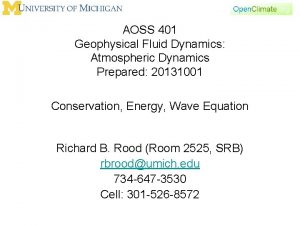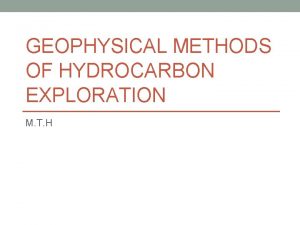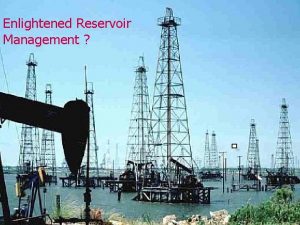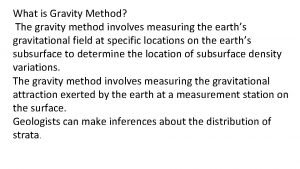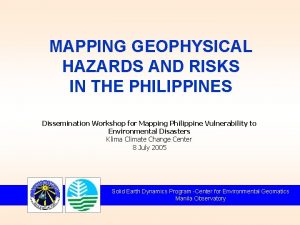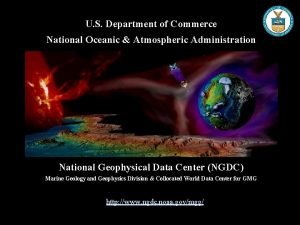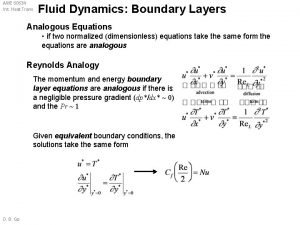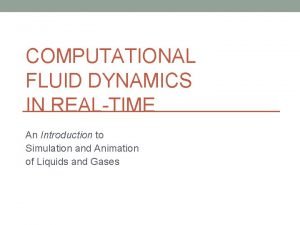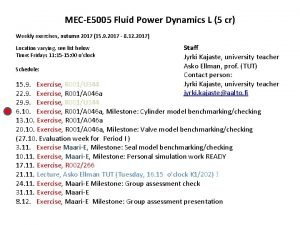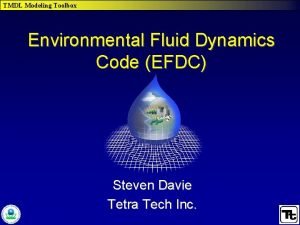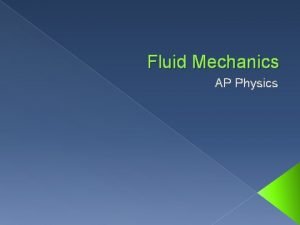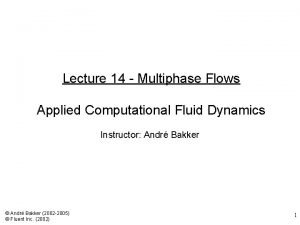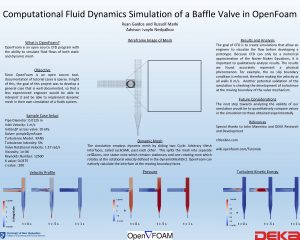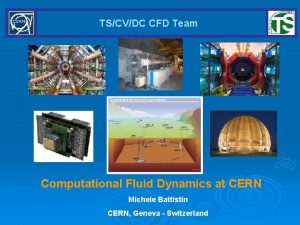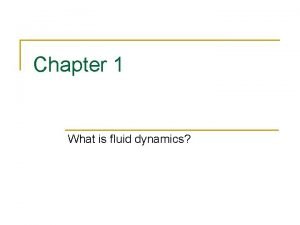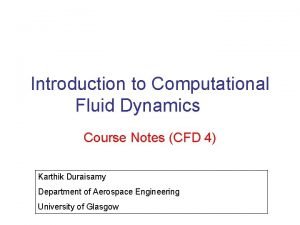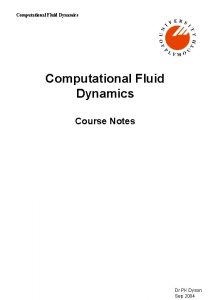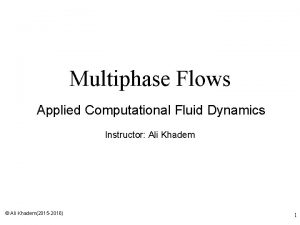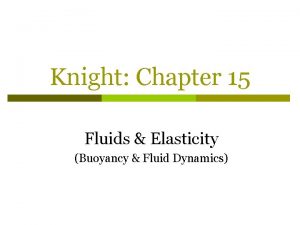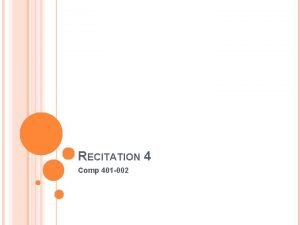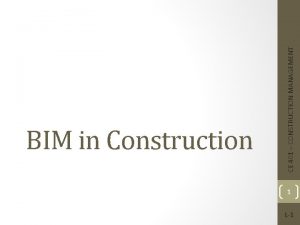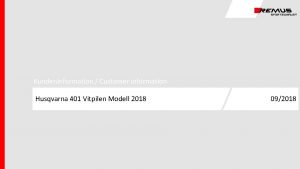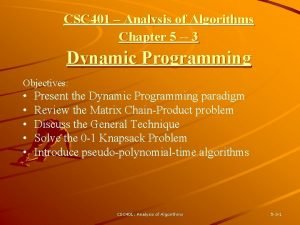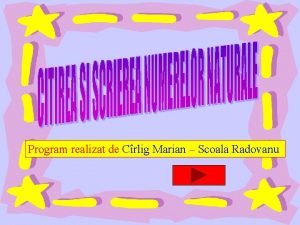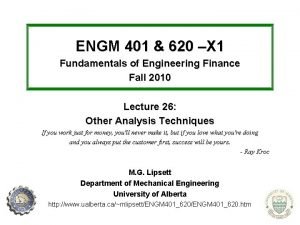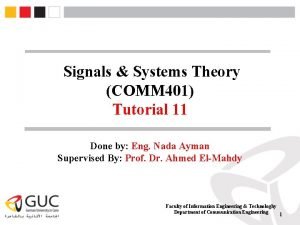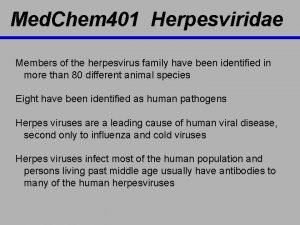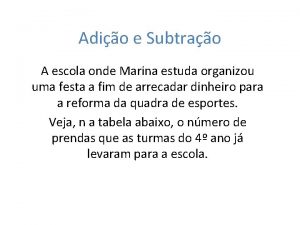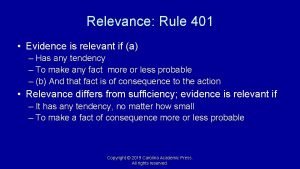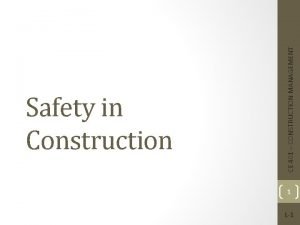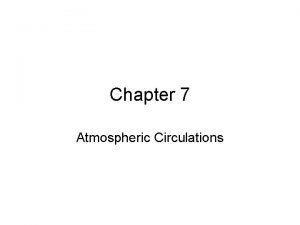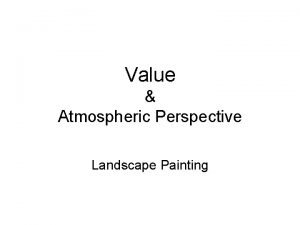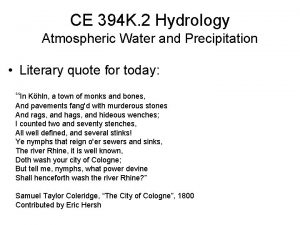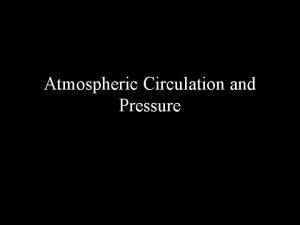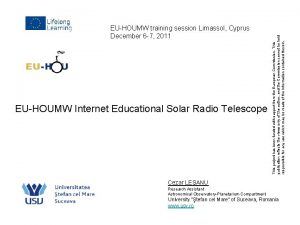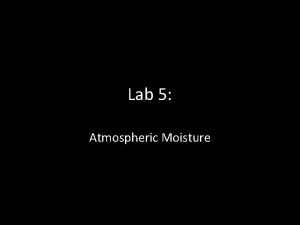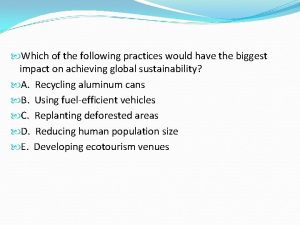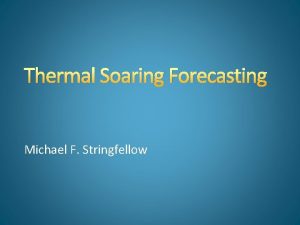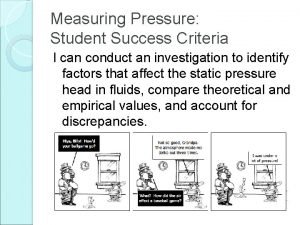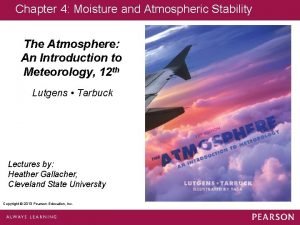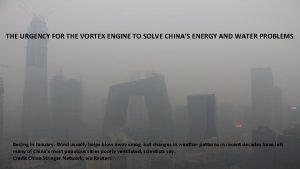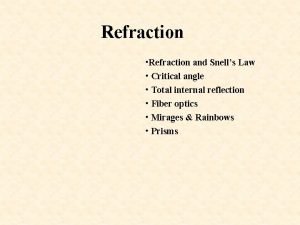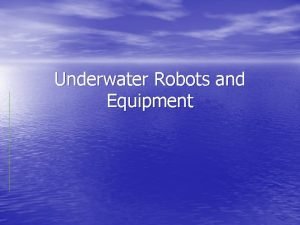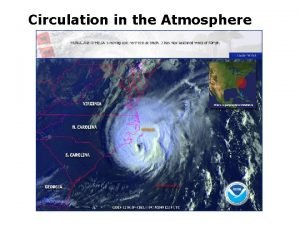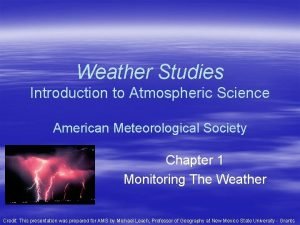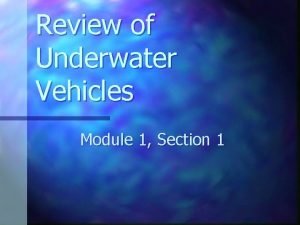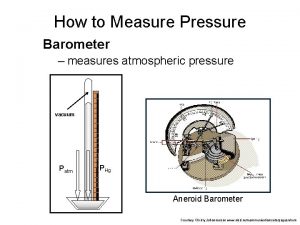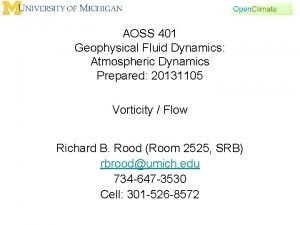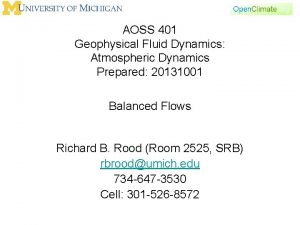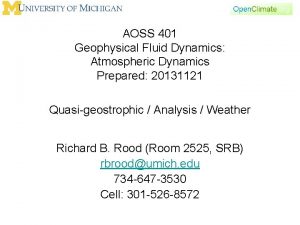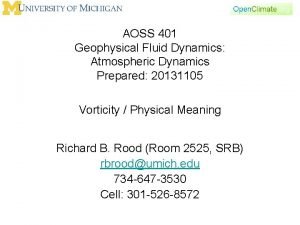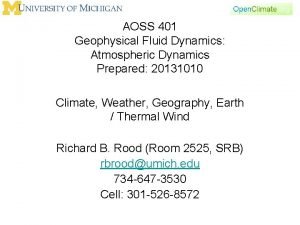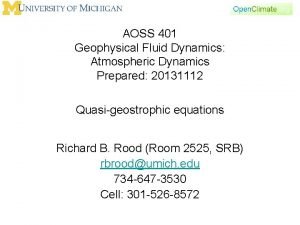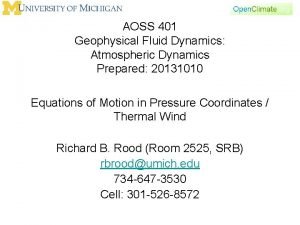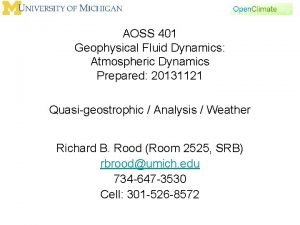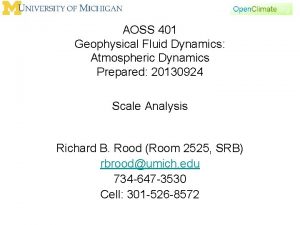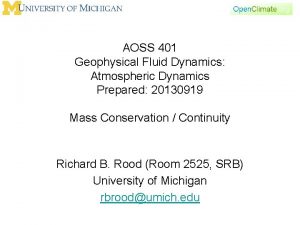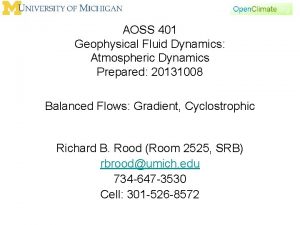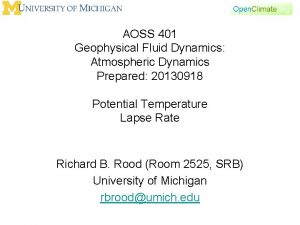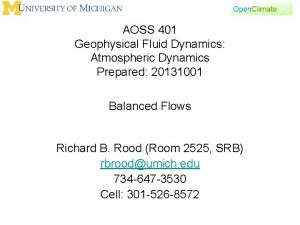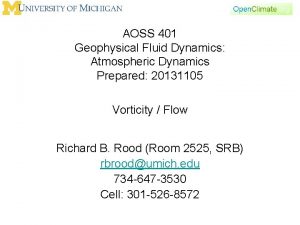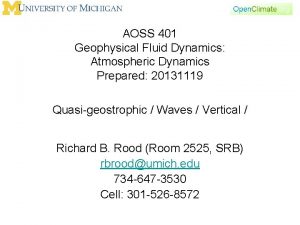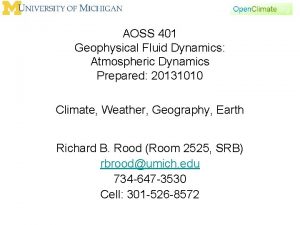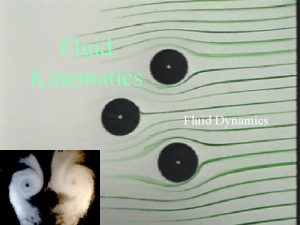AOSS 401 Geophysical Fluid Dynamics Atmospheric Dynamics Prepared






















































































- Slides: 86

AOSS 401 Geophysical Fluid Dynamics: Atmospheric Dynamics Prepared: 20131029 Rotation / Vorticity / Definition / Derivation Richard B. Rood (Room 2525, SRB) rbrood@umich. edu 734 -647 -3530 Cell: 301 -526 -8572

Class News • Ctools site (AOSS 401 001 F 13) • Second Examination on December 10, 2013 • Homework – Watch for Ctools / Email

Weather • National Weather Service – Model forecasts: • Weather Underground – Model forecasts: • NCAR Research Applications Program

Outline • Rotation in flow • Vorticity

Outline • Rotation in flow • Vorticity

Approximated equations of motion in pressure coordinates

Geostrophic wind

Thermal wind p is an independent variable, a coordinate. Hence, x and y derivatives are taken with p constant.

Schematic of thermal wind. Thickness of layers related to temperature. Causing a tilt of the pressure surfaces. from Brad Muller

A summary of ideas. • In general, these large-scale, middle latitude dynamical features tilt westward with height. • The way the wind changes direction with altitude is related to the advection of temperature, warming or cooling in the atmosphere below a level. – This is related to the growth and decay of these disturbances. – Lifting and sinking of geopotential surfaces.

Guiding questions pressure surfaces warming Earth’s surface Questions for class 1) What happens to the pressure surfaces? 2) What happens to vertical velocity? 3) What happens to horizontal divergence? 4) What happens to the surface pressure? 5) What happens to the surface winds? 6) What happens to the wind at the top of figure?

RETURN Possible development of a surface low. mass diverges up here warming H LOW H pressure gradient initiates convergence down here Earth’s surface

Wind around a system. This is the sort of system which is often called a “vortex. ” L

Where are we going next? • We have learned several important diagnostic concepts (relationships between forces, dynamics vs. thermodynamics) • We would like to understand how flows in the atmosphere change – What are the mechanisms? – Can we quantify this? – How might we predict changes in the atmospheric flow?

Rotation in the flow • Rotation is important—associated with development of high and low pressure systems • There is an interplay between rotation, divergence, and vertical motion • How to quantify and understand this?

Introduction to Vorticity (From the Detroit NWS forecast office glossary of terms) Vorticity: Simply put, the measure of rotation of an air parcel about a vertical axis. A parcel rotating clockwise is said to have negative vorticity, and a parcel rotating counterclockwise is said to have positive vorticity. There are two types of vorticity; shear vorticity, which arises from changes in wind speed over a horizontal distance, and curvature vorticity, which is due to turning of the wind flow.

Introduction to Vorticity (From the Detroit NWS forecast office glossary of terms) Vorticity: Simply put, the measure of rotation of an air parcel about a vertical axis. A parcel rotating clockwise is said to have negative vorticity, and a parcel rotating counterclockwise is said to have positive vorticity. There are two types of vorticity; shear vorticity, which arises from changes in wind speed over a horizontal distance, and curvature vorticity, which is due to turning of the wind flow.

There are parts of this definition that are not (strictly speaking) true… We will be getting a bit more technical in the coming weeks… Question: why is vorticity important?



Introduction to Vorticity (From the Detroit NWS forecast office glossary of terms) • Vorticity Maximum: (VORT MAX) An area of maximum positive vorticity. The terms vort max and short wave are often used interchangeably. Areas downwind of a vort max experience positive vorticity advection (and rising motion), while areas upwind of a vort max experience negative vorticity advection (and sinking motion).

Introduction to Vorticity (From the Detroit NWS forecast office glossary of terms) • Vorticity Maximum: (VORT MAX) An area of maximum positive vorticity. The terms vort max and short wave are often used interchangeably. Areas downwind of a vort max experience positive vorticity advection (and rising motion), while areas upwind of a vort max experience negative vorticity advection (and sinking motion).

Vorticity concepts • Positive vorticity is associated with cyclonic rotation in the northern hemisphere (low pressure systems) – Predict changes in vorticity = predict low and high pressure systems – The first computer forecasts only predicted the changes in vorticity—and did a decent job… • Conservation of vorticity tells us how weather systems interact with mountains • Can diagnose large scale vertical motion by looking at the horizontal advection of vorticity…(this is not exactly true—we will be getting a bit more technical in the coming lectures…)

Key questions: • How is positive/negative vorticity generated? • How do we describe the time rate of change of vorticity? • How do we describe conservation of vorticity (is vorticity conserved following the motion? ) • What is the role of the Earth’s rotation?

Need to formalize the representation of the role of rotation and divergence

Suppose we have some flow

Imagine at the point flow decomposed into two “components” A “component” that flows into or away from the point.

Imagine at the point flow decomposed into two “components” A “component” that flows around the point.

In general, can imagine a “circulation” around a point. Circulation based on the component of velocity tangent to some curve summed around the curve.

Circulation is a measure of rotational part of the flow. It is, formally, an analogue to angular momentum and we can write a conservation equation for it. We define a “direction” of circulation by which direction we go around the circuit. cyclonic – counterclockwise anticyclonic -- clockwise

How would we quantify this? • In this case: • Our coordinate system does not change • We keep track of information about the atmosphere at a number of (usually regularly spaced) points that are fixed relative to the Earth’s surface

Pure constant rotational flow. .

Pure flow towards / away from point .

Complete representation of flow .

Rotational and irrotational flow • Flow can be completely represented by a rotational and an irrotational part of the flow. • Rotational flow is represented by the curl of the velocity and irrotational flow by the divergence of the velocity – This is Helmholtz’s theorem • Curl of the velocity is called the vorticity • Nice discussion of curl and divergence

Need to formalize the representation of the role of rotation and divergence

Vorticity • A picture – of a sort

Lets consider a spinning skater

Lets consider a spinning skater Motion is in the (x, y) plane Axis of rotation is in the vertical plane

Important mathematical and physical operators We have seen the dot product or divergence.

Important mathematical and physical operators Which is the definition of vorticity.

A pause with circulation • Vorticity is related to “circulation. ” – Vorticity is a measure of rotation linked to a point in a fluid. – Circulation is a measure of rotation measured around a closed circuit. . . an area average. • Vorticity is as fundamental a description of the fluid motion as, for example, wind. • Flow can be completely described by vorticity + divergence. – rotation + vertical velocity • Circulation is an important theoretical construct, but we will not study it much in this course.

In class problem • Group A • Group B – Scott – Anna – Alex – James – Justin – Kevin – John – Ross – Rachel – Trent – Jordan

How to compute the time rate of change of vorticity? • If the change in vorticity is important (development of highs and lows), we need a way to compute it • We already have the tools to do this!

How do you solve this set of equations?

The answer • Multiply each of the equations by something. (Do something to the equation) • Add (or subtract) them.

The scaled horizontal momentum equation in z coordinates no viscosity

Relative Vorticity

Take derivatives

Take derivatives

Take derivatives

Take derivatives Two groups: Take the terms in the rectangle and discuss how to arrive at an equation that represents the time rate of change of the vertical component of relative vorticity. Start the derivation, which requires that you expand the advective terms using the product rule.

Back to lecture

Vorticity

Vertical Component of Vorticity In what plane is the motion? In what direction is the vorticity?

Relative Vorticity

Vorticity

Planetary Vorticity • Vorticity due to the rotation of the Earth • We will spend most of our time during this lecture thinking about relative vorticity, but let’s first think about the concept of planetary vorticity… • (this will become important later when we start looking at waves in more detail)

Ω k Maximum rotation of vertical column. Ω k Picture of Earth Ω k No rotation of vertical column.

Planetary Vorticity

Picture of Earth 1. 4 X 10 -4 s-1 1. 0 X 10 -4 s-1 0. 0 s-1 f=2Ωsin(Φ)

Absolute (or total) Vorticity

Wind around a system. This is the sort of system which is often called a “vortex. ” It is dominated by rotation. Do all curved flows have vorticity? L Answer: Most, but not all…

Does this flow have vorticity? lines of constant geopotential or pressure ∂y ~ Δy north south ∂x ~ Δx west Draw a picture! east

Does this flow have vorticity? lines of constant geopotential or pressure ∂y ~ Δy north south ∂x ~ Δx west Draw a picture! east

Does this flow have vorticity? What happens to this stick? ∂y ~ Δy north south ∂x ~ Δx west Draw a picture! east

Does this flow have vorticity? What happens to this stick? ∂y ~ Δy north south ∂x ~ Δx west Draw a picture! east

Does this flow have vorticity? What happens to this stick? ∂y ~ Δy north south ∂x ~ Δx west Draw a picture! east

Does this flow have vorticity? What happens to this stick? north ∂y ~ Δy ∂v/∂x-∂u/∂y south ∂x ~ Δx west Draw a picture! east

A question • Does the previous example tell you something about the ground? • Does the flow in the previous example have divergence?

Vorticity • Related to shear of the velocity field.

Divergence • Related to stretching of the velocity field.

Why is the divergence important?

A part of the answer… Vertical wind is related to divergence of the horizontal wind. (Which requires an ageostrophic part of the wind. ) We will come back to this in a moment, but first…

How to compute the time rate of change of vorticity? • If the change in vorticity is important (development of highs and lows), we need a way to compute it • We already have the tools to do this!

How do you solve this set of equations?

The answer • Multiply each of the equations by something. (Do something to the equation) • Add (or subtract) them.

Full equations of motion Remember these? How would you calculate of the time rate change of the vertical component of vorticity?

The scaled horizontal momentum equation in z coordinates no viscosity

Relative Vorticity

Take derivatives

Take derivatives

Take derivatives

Take derivatives Pay attention to details of calculus here

Subtract these equations: Conservation of vorticity (A rather long derivation—and a great homework problem…)

Take away points
 Geophysical fluid dynamics
Geophysical fluid dynamics Gravity method of geophysical exploration
Gravity method of geophysical exploration Reservoir geophysical corporation
Reservoir geophysical corporation Latitude correction gravity formula
Latitude correction gravity formula Basilan and romblon tsunami
Basilan and romblon tsunami National geophysical data center
National geophysical data center Solute definition
Solute definition Shifting dullness vs fluid thrill
Shifting dullness vs fluid thrill P1-p2
P1-p2 Hypoosmotic
Hypoosmotic Fluid statics deals with fluid at rest
Fluid statics deals with fluid at rest Fluid mechanics chapter 4 solutions
Fluid mechanics chapter 4 solutions Total body water
Total body water Movement of body fluids
Movement of body fluids Synovial membrane
Synovial membrane Computational fluid dynamics
Computational fluid dynamics Fluid dynamics
Fluid dynamics Real-time fluid dynamics for games
Real-time fluid dynamics for games Fluid power dynamics
Fluid power dynamics Equation of fluid
Equation of fluid Computational fluid dynamics
Computational fluid dynamics Environmental fluid dynamics code
Environmental fluid dynamics code Fluid dynamics
Fluid dynamics Computational fluid dynamics
Computational fluid dynamics Fluid dynamics
Fluid dynamics Maysam mousaviraad
Maysam mousaviraad Fluid dynamics definition
Fluid dynamics definition Cfd notes
Cfd notes Colloid osmotic pressure
Colloid osmotic pressure Computational fluid dynamics
Computational fluid dynamics Computational fluid dynamics
Computational fluid dynamics Fluid dynamics
Fluid dynamics Lsp401
Lsp401 404 asphalt
404 asphalt Stitch type 401
Stitch type 401 Hinário adventista 401
Hinário adventista 401 Food code 3-401 be displayed texas
Food code 3-401 be displayed texas Comp 401
Comp 401 Ce-401
Ce-401 Jul 401 english
Jul 401 english Bmb 401
Bmb 401 Svartpilen 401 dyno
Svartpilen 401 dyno Csc 401
Csc 401 Hd-wp-4k-401-c
Hd-wp-4k-401-c Scoala radovanu
Scoala radovanu Eng m 401
Eng m 401 401 west georgia street vancouver
401 west georgia street vancouver Worldwide product division structure
Worldwide product division structure Ir 401
Ir 401 Comm 401
Comm 401 Cse401
Cse401 Concurrent engineering disadvantages
Concurrent engineering disadvantages Herpesviridae
Herpesviridae Clase 401
Clase 401 Nia 610
Nia 610 Heat stabilised film
Heat stabilised film Quantas prendas faltam para a turma 401 empatar com a 402
Quantas prendas faltam para a turma 401 empatar com a 402 401 relevance
401 relevance Ge 401
Ge 401 Ce-401
Ce-401 Multithread chain stitch
Multithread chain stitch 401 branard st
401 branard st Single cell model of atmospheric circulation
Single cell model of atmospheric circulation Atmospheric perspective landscape
Atmospheric perspective landscape Atmospheric vortex engine
Atmospheric vortex engine Atmospheric refraction
Atmospheric refraction Atmospheric convection
Atmospheric convection Single cell model of atmospheric circulation
Single cell model of atmospheric circulation Atmospheric opacity
Atmospheric opacity Lab 5 atmospheric moisture
Lab 5 atmospheric moisture Atmospheric chemistry suite
Atmospheric chemistry suite Exemplified by starlings displacing bluebirds
Exemplified by starlings displacing bluebirds Rasp soaring forecast
Rasp soaring forecast Gauge pressure formula
Gauge pressure formula Atmospheric definition
Atmospheric definition Atmospheric stability
Atmospheric stability Atmospheric vortex engine
Atmospheric vortex engine Brewster angle
Brewster angle Atmospheric suits
Atmospheric suits Atmospheric reaction
Atmospheric reaction Atmospheric convection
Atmospheric convection Atmospheric circulation
Atmospheric circulation Atmospheric physics lecture notes
Atmospheric physics lecture notes Air pressure at different altitudes
Air pressure at different altitudes American meteorological society
American meteorological society Atmospheric diving suit
Atmospheric diving suit Barometer
Barometer
